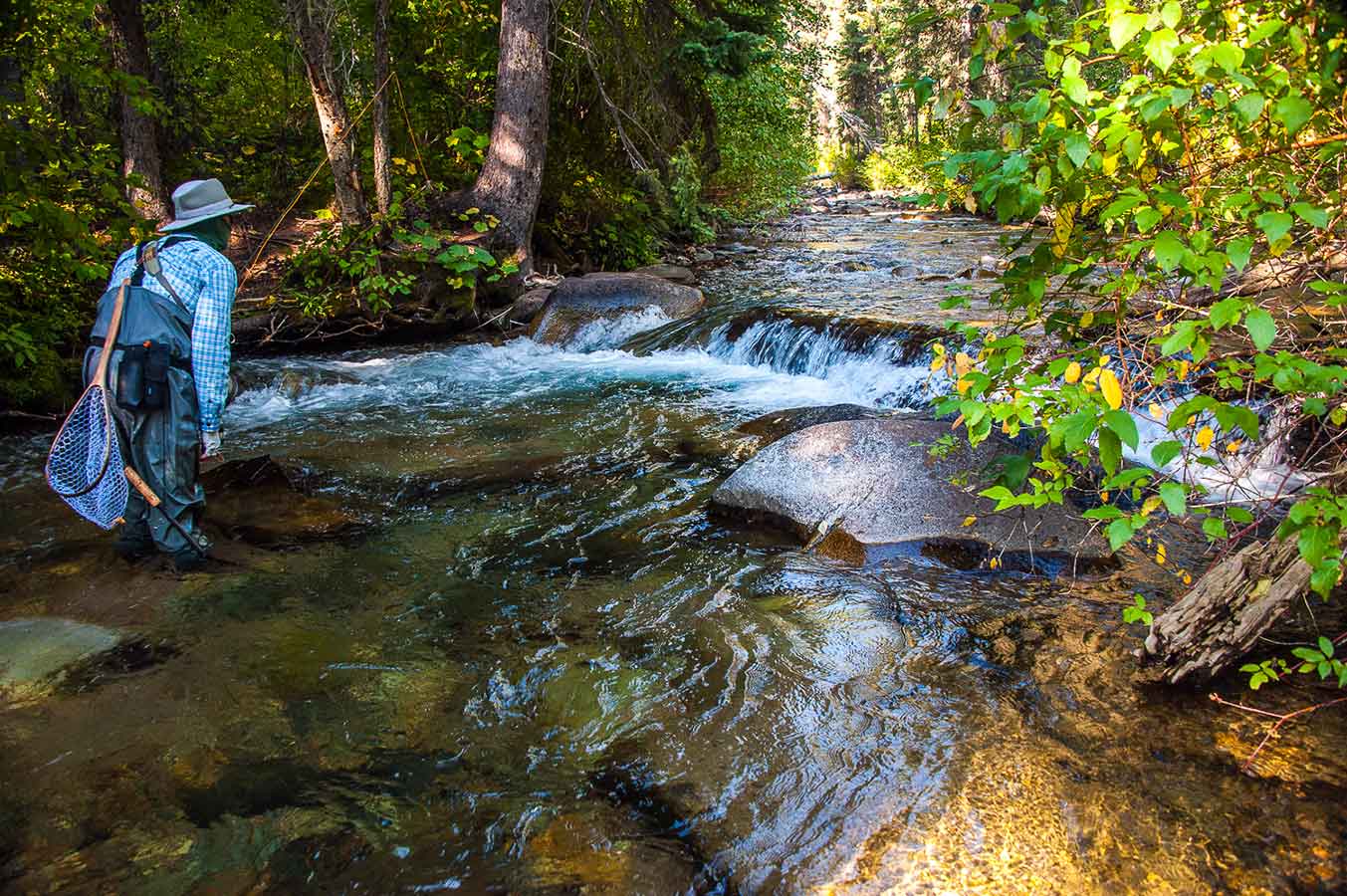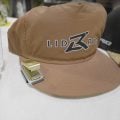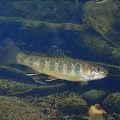How to Fish High Mountain Creek Pools

Carol Ann Morris photo
Question: I fly fish steep-gradient creeks in the Sierra Nevada Mountains, in California. Many of these streams are not fishable except in the pools averaging four to seven feet deep. What is the best method to fish this type of water? And would one fish nymphs or streamers in such pools? —Dave B
Answer: Best method? I’ll get to that. Let’s start with the method most fly fishers would choose first: the dry fly. (Or perhaps a floating or half-floating emerger fly, but that’s usually fished just as a dry is usually fished so, really, same thing.) Why would they go with a dry? Because in fishing creeks, they can—trout in most creeks are hungry and consequently aggressive, ready to grab whatever comes along, mayfly dun, stonefly nymph, trout fry, tiny streamer, bead-head nymph, hairy heavily dressed dry fly. If most fly fishers can fish a dry fly and catch plenty of trout, they will, because it’s fun, because the action’s plain to see and delight in, and dry-fly fishing is generally easier and neater than nymph fishing.
But the any-fly-goes-on-creeks rule is far from reliable. In high flows, creeks make going after dry flies too much work or trout; nymphs and larvae are swept right through the places that provide shelter for trout from that angry water and therefore an artificial nymph then is likely more, or much more productive than a floating fly. Another scenario: nymphs all of a type are stirring down there, preparing to hatch—the trout of that creek, if they have a lick of good sense, will stay down there and get their fill while the plenty lasts. Sometimes creek trout will simply refuse a dry fly, any dry fly, for no apparent reason. Perhaps just because they can.
Knowing when to abandon the floating fly on creeks is normally easy enough to figure out: if the trout won’t take it, try something else. Sure, you can see if your trout are in a discerning mood by presenting them a range of dries and floating emergers, even giving those flies twitches, or tugs to make them skim the water. But if you know the trout are there and they’re ignoring your efforts, let go of the floating fly. Try a nymph.
So go ahead, pick out a nymph that seems plausible, perhaps a Gold Ribbed Hare’s Ear or a Prince, in creek-trout size; I’d go size 16 to 12. In creeks I like to fish lightly weighted nymphs below tiny strike indicators the size of a green pea up to the size of a small grape. In quiet creeks a hank of knotted-on floatant-treated synthetic yarn (fly-tier’s Poly yarn is good) will drop lightly so as not to alarm fish and will do its job as an indicator. But there’s always the dry-and-dropper rig: a small nymph, around size 16 or 18, dangled from the bend of a medium-size, buoyant dry fly, say a size 10, on a foot or two (or more) of tippet.
Sometimes, trout plant themselves deep in creek pools and will not come up. Perhaps they’re just in a mood, or perhaps they spend the sunny midday hours tucked out of sight from predators under a rock ledge. In either case, a nymph halfway to the creek bed isn’t enough—you need to get your nymph fully down among those fish. To get a nymph deep in the short span of a creek pool, you’ll probably need to cast your fly way up where the water pours in at the pool’s head; the farther the nymph drifts, the deeper it gets. Of course you can fish a really heavily weighted nymph, add a split shot onto the tippet a foot or so above the nymph, or both. Such weight, combined with a delivery of the fly at the head of the pool, will surely do the job. If you use heavy nymphs, you’ll likely need not a dry fly but a real strike indicator, I you add shot the indicator becomes mandatory. But there’s another option.
Czech nymphing (or Euro-, or tight-line, or contact nymphing—it’s a method that can’t decide on its own name) is bigger than ever today. Bigger over here in North America, that is; it was big quite some while ago in Europe. It uses no indicator and a rig of two or three weighted nymphs. The nymphs, the point nymph in particular, is normally tied on a Czech jig hook, fitted with a slotted tungsten bead to hurry the fly, and its droppers, to depth. The flies are lobbed upstream—it would be sinful to call it a cast—and then allowed to drift along the streambed, the rod-tip leading them just enough to keep tension on them, to keep the angler in touch with them. Most of the creeks I fish, be they 25 minutes of driving or two states away, are hemmed in by trees and brush—so the long rods normally associated with this fishing can be a problem. But you can Czech nymph on a creek with shorter rods. I know, I’ve done it.
Here’s a neat trick for getting nymphs down fast. Somewhere in most pools is a seam, a folding together of currents that throws downwards. Just look for a line on the surface where it seems the water on both sides is converging. If you drop your nymph right on that seam, the current will hurry it down—you may be able to reach the bed without a really heavy nymph or split shot. (If you’re using a strike indicator, you’ll need to drop it near the seam too.) The drawback: you can only cover one strip of the bottom this way.
Hatches can happen on creeks, and some creek trout are smart. Get a creek full of smart trout onto a hatch and you might as well be fishing a rich meandering spring-fed stream for brown trout sipping down Blue-Winged Olive mayflies: upper-level fishing, what is popularly called “technical fishing.” “Technical trout-creek fishing” probably sounds to some like an oxymoron. They just haven’t fished enough creeks.
When bugs are hatching and trout are rising, show those trout respect. They may demand it.
What about swung flies, the wets and soft-hackles? Swinging requires enough room to stand across from the trout and let the fly literally swing across and downstream, and enough room to slow the swing with mends—creeks don’t provide that room. You can dangle a wet fly or soft hackle straight downstream and get hits; I know, I’ve done it. But you’ll hook the trout at the head of the pool first and panic all the others downstream of it, since trout must face into the current. You’ll mess up the entire pool on your first fish. Not good.
So, to sum all that up: floating flies will likely do the job on your creeks, but if they won’t, do try nymph fishing. Soft-hackles and wet flies? Maybe, but probably not, at least not fished on the conventional swing. And don’t underestimate creek trout because if you do, the odds skyrocket that they’ll show you just how cautious they can be.
You asked about fishing streamers, Dave; they represent a fuzzy proposition for creek fishing. Hardly anyone seems to fish these flies in creeks. Although, I’ve done it, and have caught a few monster creek trout of up to 16 inches doing it. (Yes, that’s a monster on most of the creeks I fish. But yes, there are considerably bigger trout in some creeks, and I’ve hooked a few of those too, just not on streamers.) Unless you’re fishing a freak creek holding serious numbers of big trout, you’ll probably want little streamers, size 10s, 12s, probably 8s at the top end. Streamers are often swung across the current, in roughly the same way soft-hackles are swung, but you can’t do that on creeks. So instead, you can let a weighted streamer sink and then tug it up and let it drop so that it head-bobs down through the pool. Or you can feed it down into a pool and hope one big trout comes after it—once that happens, the pool is probably shot for a good while.
What you didn’t ask about, Dave, but I feel needs to be covered here: stealth. Pretty much everything I’ve said means little without it. A smacked-down dry fly, your rod’s or your own shadow sliding across the pool’s cobbled bed, moving around tall and openly at the head of a pool—these and any other similarly trout-alarming or even trout-alerting activity will put trout off of dry flies, nymphs, streamers, and even real bugs. A trout living in a creek pool knows the score: he’s trapped in a pocket of clear water amid all sorts of swimming and diving things with teeth and beaks. Things that consider him a delicacy. He’s jumpy, alert, even paranoid all the time. He should be. And we all should bear that in mind when we go to catch him.











